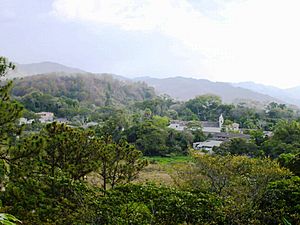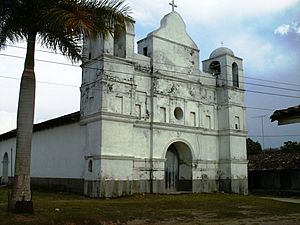Tambla facts for kids
Quick facts for kids
Tambla
|
|
|---|---|
|
Municipality
|
|

An Overview of town
|
|
| Country | Honduras |
| Department | Lempira |
| Villages | 4 |
| Municipality since | 11 September 1896 |
| Area | |
| • Total | 59 km2 (23 sq mi) |
| Population
(2015)
|
|
| • Total | 3,221 |
| • Density | 54.6/km2 (141.4/sq mi) |
| Time zone | UTC-6 |
Tambla is a small town and a municipality in the Lempira department of Honduras. It is one of the many towns in this area. To get to Tambla, it's best to travel through Santa Rosa de Copán, then San Marcos de Ocotepeque, and Cololaca.
Contents
History of Tambla
Tambla was first located in a village called "El Zorrillal." The land there was very dry, so everyone decided to move. They settled in a new place known as "Pueblo Viejo."
In 1887, Tambla was considered a village that belonged to Tomalá. Later, on September 11, 1896, the government officially made Tambla its own municipality.
Geography and Climate
Tambla is built on top of a mountain. It is surrounded by many other large mountains. These mountains are covered with thick pine forests.
The weather in Tambla is usually cool all year round. During the summer, the temperature goes up a little, but it generally stays pleasant.
Where is Tambla Located?
Tambla shares its borders with several other towns:
- North: Tomalá municipality.
- South: Guarita and Valladolid municipalities.
- East: San Andrés and Tomalá municipalities.
- West: Guarita municipality.
The total area of Tambla is about 59 square kilometers.
Economy and Resources
Tambla is a great place for growing coffee. This is because it is located high above sea level, which is perfect for coffee plants.
After coffee, raising cattle is another important activity. People also grow beans and corn. Buying and selling goods, known as commerce, is also a big part of the local economy.
Like other towns in the Lempira department, Tambla has electricity in its main town. There is also mobile phone service available.
Population and People
In 2001, about 2,314 people lived in Tambla. By 2015, the population was expected to grow to 3,221 people.
The municipality of Tambla includes:
- 4 main villages.
- 40 smaller settlements.
Who Lives in Tambla?
A census in 2013 showed the different groups of people living in Tambla:
- About 68% were Mestizo (people of mixed European and Indigenous heritage).
- Around 27.5% were Indigenous, mostly Lenca people.
- About 4% were White.
- A small number, less than 1%, were Black or Afro-Honduran.
Tourism and Local Attractions
Getting to Tambla takes about two hours. The road to Cololaca is being paved, and after Cololaca, the road is in good condition. Some parts of the road have narrow curves, so it's important to drive carefully. Tambla is only about 10 minutes away from Tomalá.
Tambla has several interesting places to visit:
- There is a statue and a plaque honoring Chief Lempira. He was a brave leader of the Lenca people.
- You can also see a very old "Ceiba" tree. It stands by the road that leads to Valladolid.
- The people in Tambla are very friendly. They are always happy to share stories about their town.
- With grocery stores and electricity, visiting Tambla is comfortable. It is also a very quiet town, perfect for a break from city noise.
Local Celebrations
Tambla celebrates two main local holidays:
- San Francisco de Asis Day: This is celebrated on October 4.
- Inmaculada Concepción Day: This holiday is celebrated on December 8.
Images for kids
See also
 In Spanish: Tambla para niños
In Spanish: Tambla para niños





